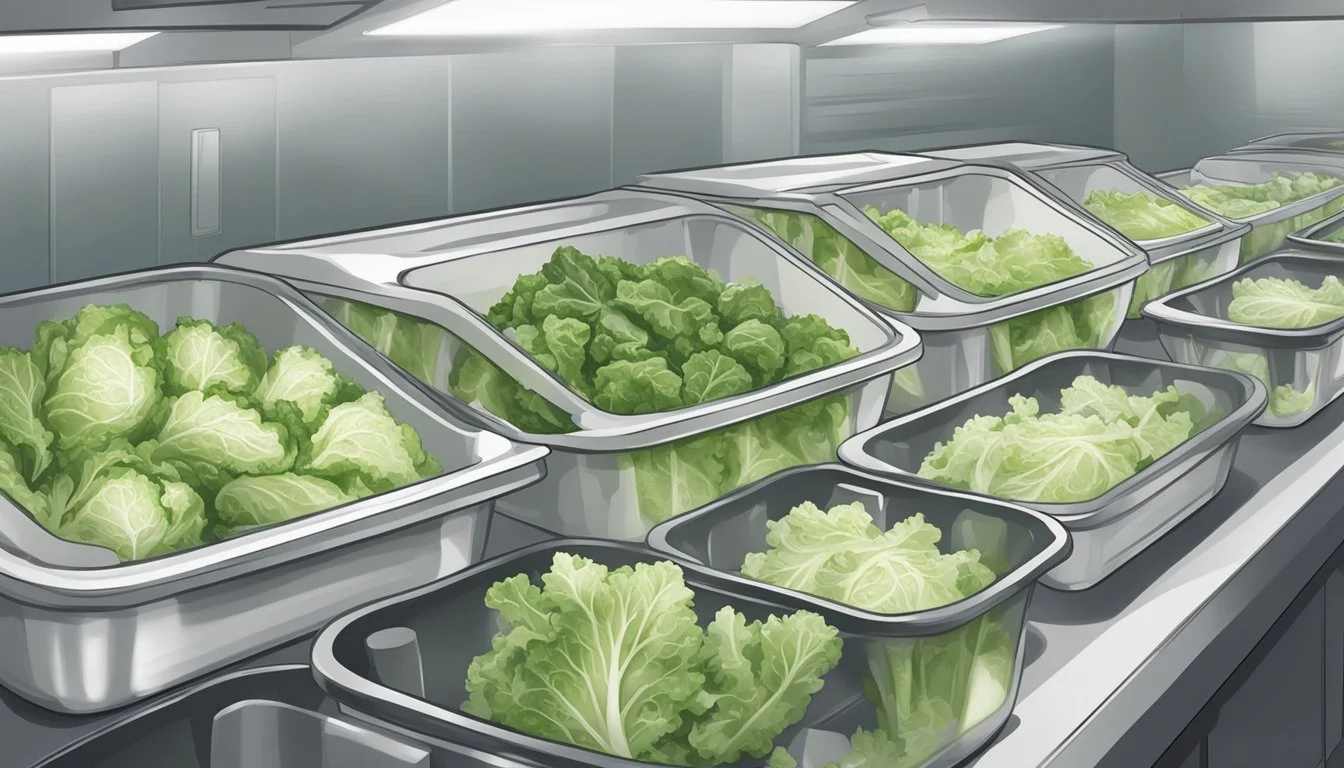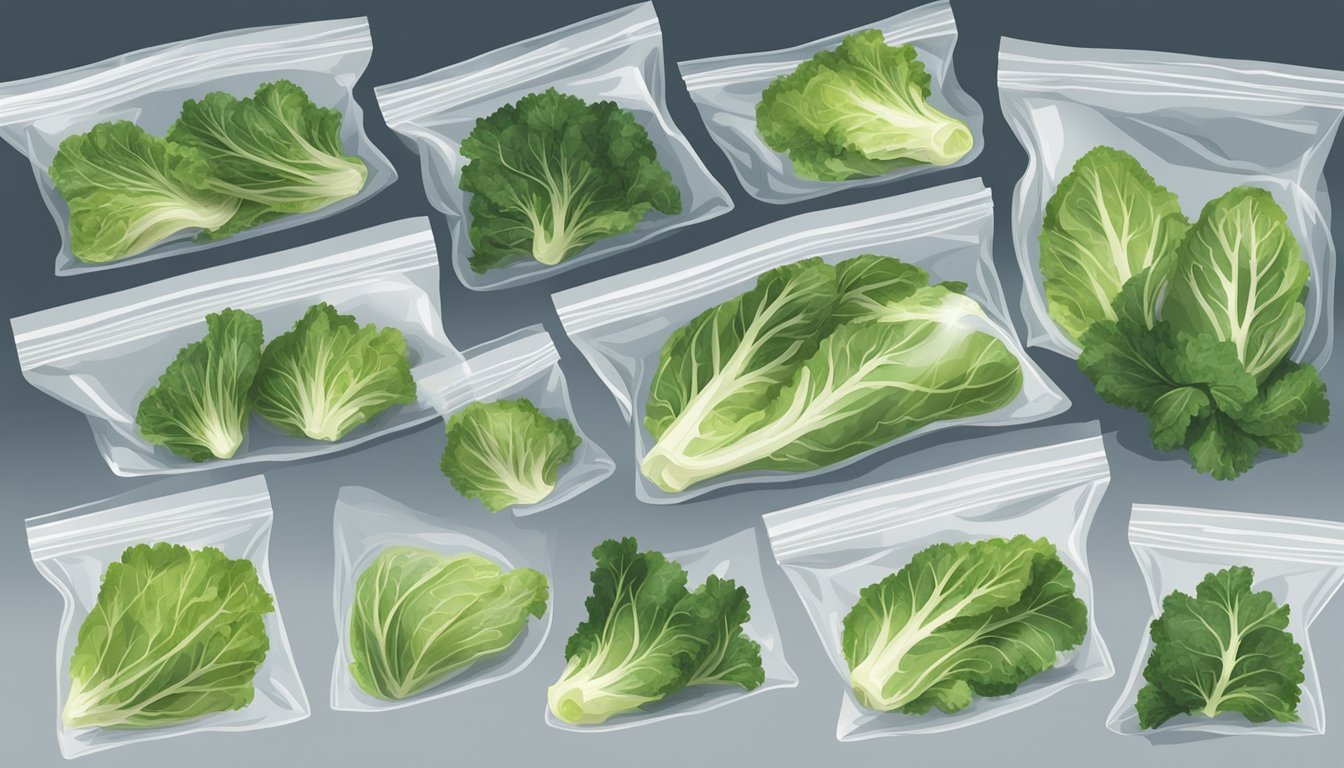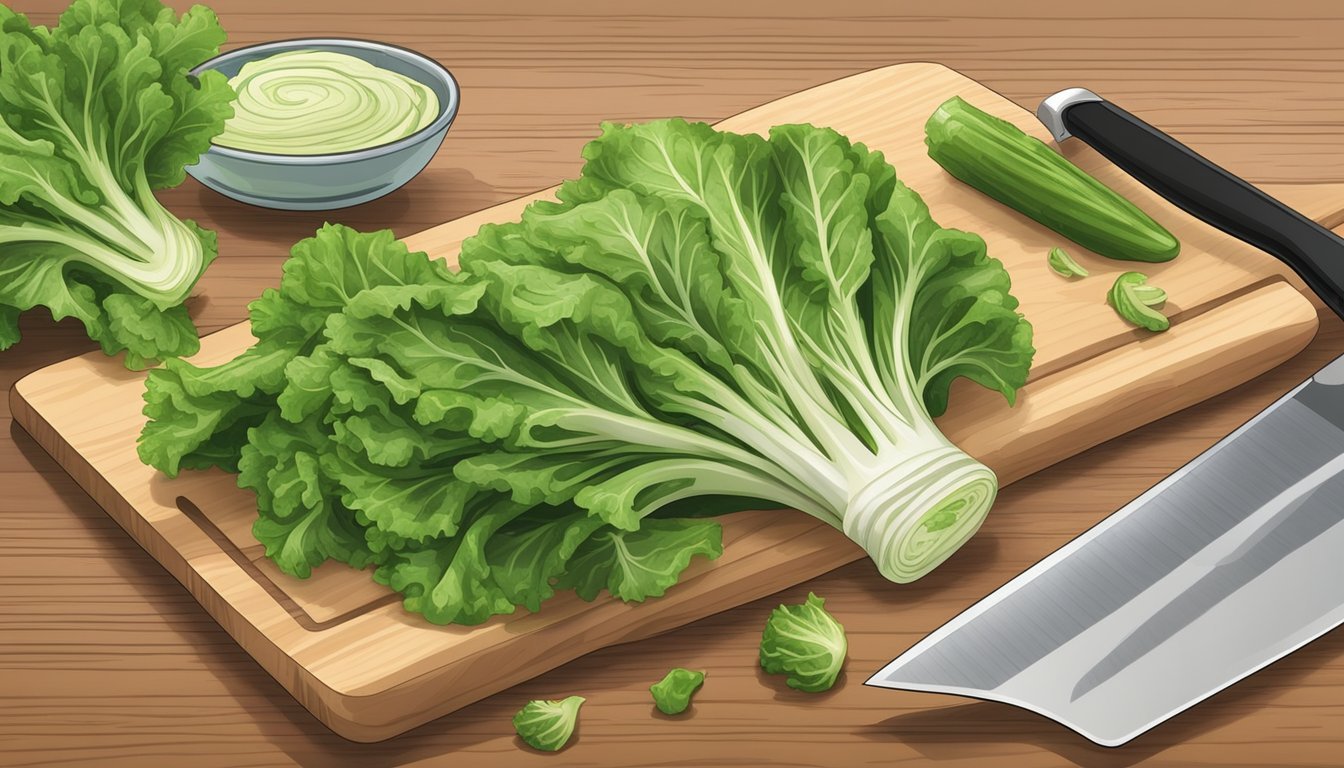How to Freeze Fresh Escarole for Soups and Sautes
A Step-by-Step Guide
Escarole, a leafy green vegetable belonging to the chicory family, is valued not only for its nutty flavor and versatility but also for its nutritional benefits. Rich in vitamins A, K, and C, as well as dietary fiber and minerals, it is a healthful addition to any diet. Preserving the freshness and nutritional content of escarole can be a challenge, but freezing offers a practical solution. When properly prepared, frozen escarole can retain much of its nutritional value, making it a convenient ingredient for future soups (What wine goes well with soups?) and sautés.
The process of freezing escarole requires careful handling to maintain its quality. To ensure freshness is preserved, it is best to start with crisp, fresh escarole. Washing the leaves thoroughly under cold running water is essential to remove any dirt or debris. Blanching, a quick cook in boiling water followed by an immediate plunge into ice water, is a key step that helps to lock in the color, flavor, and nutritional content of the escarole before it is frozen.
After blanching, escarole must be dried completely to prevent the formation of ice crystals, which can degrade its texture. Once dry, the escarole can be portioned into usable amounts, packed in airtight, freezer-safe containers or bags, and labeled with the date. This preparation allows escarole to be used conveniently for cooking, as it can be added directly to hot dishes such as soups and sautés without the need for thawing, offering both freshness and nutrition to meals year-round.
Benefits of Freezing Escarole
Freezing escarole can extend its shelf life, offering more flexibility for future meal planning. Normally, fresh escarole may only last a few days in the refrigerator before wilting or becoming unpalatable. However, when properly frozen, escarole can be preserved for several months, allowing one to enjoy its flavors outside its typical growing season.
Nutrition is another important consideration. Escarole, a leafy green, retains most of its nutritional value when frozen. The quick-freezing process helps to lock in vitamins and minerals, making frozen escarole nearly as nutritious as its fresh counterpart. This is particularly advantageous for people who prioritize a healthy diet and seek to have a constant supply of greens on hand.
When it comes to food preparation, frozen escarole is notably convenient for soups and sautés. It can be added directly to hot dishes without the need for a time-consuming thaw. This ease of use can make cooking more efficient, as the leafy green is pre-washed and ready to be utilized in various recipes.
In summary, freezing escarole is practical for preserving the vegetable's:
Freshness
Nutritional value
Taste
Below is a quick reference chart summarizing the benefits of freezing:
Benefit Description Extended Shelf Life Keeps escarole usable for months. Retained Nutrition Preserves vitamins and minerals. Cooking Convenience Escarole can go directly from freezer to stove.
Incorporating frozen escarole into one's diet is a smart strategy for maintaining a supply of healthy greens ready for culinary use.
Selecting and Preparing Escarole for Freezing
When freezing escarole, it is essential to choose fresh greens and prepare them properly to maintain quality. This ensures that the escarole retains its texture and flavor when used later in soups and sautés.
Choosing the Best Escarole
Selecting fresh, high-quality escarole is critical. One should look for leaves that are bright green, crisp, and free from any signs of wilting or browning. The greens should emit a fresh, slightly sweet scent indicating their freshness. Any escarole with discolored spots or a sour odor is best avoided as this suggests the vegetable might be past its prime.
Washing and Cleaning
Once the best escarole is selected, the next step is proper cleaning:
Rinse the escarole thoroughly under cold running water to remove any dirt or sand.
Gently shake off excess water or use a salad spinner to dry the leaves without damaging them.
Cleaning the escarole before freezing is crucial as it removes any residual dirt, ensuring that it is ready to use directly from the freezer.
Trimming Outer Leaves
The outer leaves of escarole are often tougher and may have more imperfections:
Carefully remove and discard any damaged or bruised outer leaves.
Trim the base of the escarole if the ends look discolored or dried out.
Trimming not only helps in selecting the tender parts of the leafy greens but also in maintaining an even texture throughout the batch that is being frozen.
Blanching Escarole
Blanching escarole ensures it retains a tender yet crisp texture and vibrant color before freezing. This step is crucial for preserving flavor and quality.
Why Blanching Is Necessary
Blanching is a necessary step before freezing escarole because it stops enzyme activity which can lead to loss of flavor, color, and texture. The process partially cooks the greens, ensuring they remain tender and vibrant when later used in soups and sautés.
Blanching Process
To blanch escarole effectively:
Prepare a pot of boiling water: Use a large stockpot, filling it with enough water to completely submerge the escarole.
Wash the escarole: Clean the leaves thoroughly to remove dirt and debris.
Cut the greens: If desired, chop the escarole into manageable sizes before blanching.
Boil the greens: Place the escarole in the boiling water. Blanch for about 2-3 minutes, until the greens are tender.
Prepare an ice bath: While the escarole blanches, ready a bowl of ice water to cool the greens quickly after boiling.
Cooling and Draining
Immediately after blanching:
Transfer the escarole to the ice bath: This stops the cooking process and maintains the crisp quality of the greens.
Drain thoroughly: After cooling, ensure the escarole is well-drained to remove excess moisture. Patting the greens dry with a towel or a salad spinner can help reduce freezer burn when stored.
Storing and Freezing
For optimal freshness and to retain flavor, escarole must be properly stored before freezing. The storage involves packaging, using freezing techniques, and efficient freezer management.
Packaging Escarole for Freezing
Once the escarole has been washed and blanched, it should be thoroughly drained to remove excess water. Packaging is crucial to prevent freezer burn and maintain quality. Use freezer bags or airtight containers for storage. Excess air should be removed from freezer bags - vacuum sealing is optimal to extend the shelf life. If using containers, ensure there is only minimal headspace left to accommodate expansion from freezing.
Freezing Techniques
The escarole should be frozen quickly to preserve its texture and nutritional value:
Blanching: Blanching the escarole before freezing helps retain color and nutrients. Immerse it in boiling water for two minutes, then promptly cool in ice water.
Pre-freezing: Lay escarole flat on a baking sheet lined with wax paper to freeze individually. Once frozen, transfer into your selected packaging.
Flash Freezing: For more rapid freezing, a freezer with a flash freeze feature can be utilized if available.
Labeling and Freezer Management
Labeling each package with the contents and the date of freezing is key for effective freezer management. Store escarole at a consistent temperature, ideally at 0°F (-18°C) or colder, to maintain its quality. Regularly rotating items in the freezer ensures that nothing remains frozen longer than necessary. For best quality, escarole should be used within 6 months; however, it will remain safe to consume beyond this period.
Using Frozen Escarole
When incorporating previously frozen escarole into dishes, chefs should be conscious of proper thawing and preparation techniques for optimal taste and texture. Frozen escarole is versatile and can be used in various recipes that call for greens.
Thawing and Cooking Guidelines
To cook frozen escarole, one does not necessarily need to thaw it, particularly if it is being added directly to a hot dish like soup or a stew. If a recipe requires thawed escarole, placing it in the refrigerator overnight is advised. For a quicker method, one can run the escarole under cold water, ensuring it's evenly thawed and ready for imparting its full flavor to the dish. When reheating, it is crucial to gently reheat the escarole on a low-medium setting to prevent overcooking and preserve its nutritious value.
Incorporating into Soups and Sautes
Escarole's hearty texture makes it ideal for soups and sautés. In the case of soup, such as the classic Italian wedding soup, escarole can be added directly from the freezer into the pot to simmer. It will thaw as the soup cooks, melding its flavor with the other ingredients like broth, beans, and small pasta shapes, creating a harmonious blend. When sautéing, chefs can start with olive oil and garlic, adding the frozen escarole and cooking until it wilts, integrating well with other elements of the sauté.
Alternative Uses for Frozen Escarole
Not limited to soups and sautés, frozen escarole can be an ingredient in a variety of dishes. One might consider chopping it and including it in stews or using it as a nutritious addition to Italian-style beans. It also makes for a robust component in warm salads, bringing both texture and a slightly bitter taste to the mix. It's an excellent way for chefs to incorporate greens into their meals, ensuring they utilize the escarole's full potential.
Recipes Highlighting Frozen Escarole
Frozen escarole can transform into a comforting and hearty addition to soups and sautés, retaining its slightly bitter flavor and nutritious qualities. It particularly shines when teamed with beans, in classic Italian soups, or as the star in a simple vegetarian sauté.
Escarole and Bean Soup
A staple in Italian cuisine, Escarole and Bean Soup is a nutritious and comforting dish. Cooks should start by sautéing garlic and onions in a bit of olive oil before adding the escarole to thaw and wilt. The addition of cannellini beans creates a rich, creamy texture without the need for dairy. To serve, a generous sprinkle of Parmesan cheese enhances the flavors.
Ingredients:
2 tablespoons olive oil
4 cloves garlic, minced
1 onion, chopped
4 cups chicken or vegetable broth
1 head frozen escarole, thawed and chopped
2 cans cannellini beans, drained and rinsed
Salt and pepper, to taste
Grated Parmesan cheese, for garnish
Italian Wedding Soup with Escarole
For a hearty Italian Wedding Soup with Escarole, one should simmer frozen escarole alongside petite meatballs in a savory chicken broth. Small pasta like acini de pepe often makes an appearance in this soup, coupled with a finish of freshly grated Parmesan to complement the subtle bitterness of the escarole.
Ingredients:
Meatballs (beef or chicken)
4 cups chicken broth
1 head frozen escarole, chopped
1/2 cup acini de pepe or orzo pasta
Parmesan cheese, freshly grated
Vegetarian Escarole Saute
A Vegetarian Escarole Saute showcases the greens in a simple, yet delicious manner. Garlic and a dash of red pepper flakes are sautéed in high-quality olive oil before the escarole is added to the pan to thaw and soften. It's a versatile dish that can accompany a variety of proteins or stand alone as a light entrée, sprinkled with toasted nuts or shaved Parmesan for added flavor and texture.
Ingredients:
2 tablespoons olive oil
4 cloves garlic, sliced
1/4 teaspoon red pepper flakes
1 head frozen escarole, thawed and chopped
Salt and pepper, to taste
Parmesan cheese, shaved
Each recipe here can be adapted to one's liking but always centers around the rich and earthy flavor of escarole. Whether served steaming hot as a soup or sautéed to tender perfection, frozen escarole adds depth and nutrition to these classic dishes.
Tips and Tricks for Best Results
When freezing fresh escarole for soups and sautés, one should ensure to follow food safety guidelines and proper techniques to maintain flavor and texture.
Pre-freezing escarole is a crucial step. Spread the leaves on a tray lined with wax paper to prevent sticking and place it in the freezer just until the leaves are firm. This helps to preserve the escarole's original taste and texture before transferring it to a storage container.
Temperature is critical for food safety and quality. Escarole should be frozen at 0°F or colder to inhibit bacterial growth and reduce the enzyme activities that can deteriorate the quality of the greens.
Here are some additional tips:
Blanching: To preserve color and nutritional value, blanch escarole by briefly immersing it in boiling water and then plunging it into ice water to stop the cooking process.
Draining: After blanching, ensure the escarole is thoroughly drained to minimize ice crystal formation, which can lead to a mushy texture upon thawing.
Sealing: Use airtight containers or freezer bags to package your escarole, removing as much air as possible to prevent freezer burn.
Labeling: Clearly label the storage containers with the date to keep track of how long the escarole has been frozen and use within three to six months for the best quality in soups and sautés.
Health Benefits and Nutritional Facts
Escarole is a leafy green vegetable known for its nutritional benefits and versatility in recipes such as soups and sautés. It's a rich source of vitamins and minerals and has a high nutritional value.
Nutritional Components:
Vitamin A: Essential for good vision, the immune system, and reproductive health, escarole provides a significant amount of this vitamin which also aids the heart, lungs, kidneys, and other organs.
Vitamin C: Important for the growth and repair of all body tissues, this vitamin acts as an antioxidant and helps in the absorption of iron.
Iron: Crucial for making hemoglobin, a protein in red blood cells that carries oxygen; escarole includes non-heme iron, which is found in plant-based foods.
Fiber: Prominent in escarole, fiber aids digestive health, helping to maintain bowel regularity.
Protein: While escarole is not a high-protein food, it does contribute a modest amount to a person's daily protein intake.
Nutritional Facts: Escarole is low in calories yet dense with nutrients, making it an excellent choice for anyone monitoring their calorie intake without compromising on vitamins and minerals.
Nutrient Amount per 100g Calories 17 kcal Protein 1.25 g Fiber 3.1 g Vitamin A 108 µg Vitamin C 6 mg Iron 0.83 mg
Escarole is especially favorable for those looking to increase their iron and vitamin A intake, which are vital for maintaining a healthy system. The presence of vitamin C aids in boosting immunity and enhancing iron absorption, thus rendering escarole a beneficial addition to one’s diet. The fiber content also plays a key role in supporting a healthy digestive tract.
FAQs on Freezing and Using Escarole
Can you freeze escarole?
Yes, escarole can be frozen. This process helps in preserving both its nutritional value and its slightly bitter taste, which is characteristic to this leafy green.
How do you freeze escarole for soups and sautés?
To freeze escarole:
Wash the leaves under cold water.
Blanch for a couple of minutes to retain color and texture.
Cool immediately in ice water.
Drain thoroughly to remove excess moisture.
Pack in airtight, freezer-safe containers or bags.
Does freezing affect escarole's nutrition?
Freezing escarole preserves most of its key nutrients, as the rapid process retains vitamins and minerals effectively.
How long can escarole be refrigerated?
Escarole can be refrigerated for about four to five days. It should be stored unwashed with a damp paper towel in a perforated plastic bag to maintain freshness.
How do you defrost escarole?
For best results, defrost escarole in the refrigerator overnight. Escarole can also be directly used from frozen in cooked dishes like soups and sautés.
Does escarole lose its bitter taste when frozen?
The bitter taste of escarole is slightly reduced after freezing, but it generally retains its distinctive flavor, which is often desired in various recipes.









